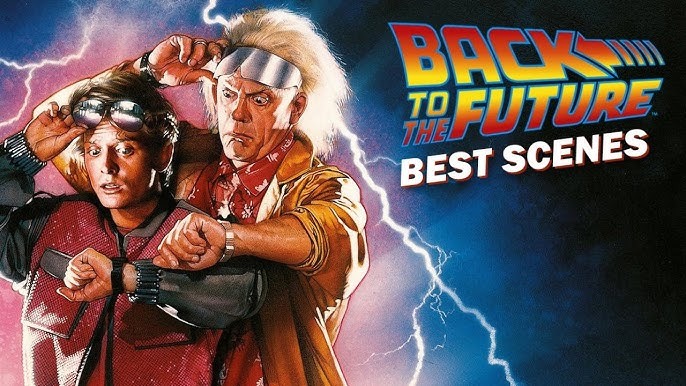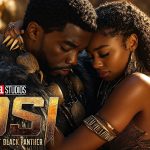Back to the Future (1985)

“Back to the Future,” released in 1985, is an iconic American science fiction adventure-comedy film directed by Robert Zemeckis and co-written by Zemeckis and Bob Gale. Produced by Steven Spielberg and featuring a star-studded cast including Michael J. Fox, Christopher Lloyd, Lea Thompson, Crispin Glover, and Thomas F. Wilson, the film has become a cornerstone of popular culture and remains a beloved classic. The movie’s innovative concept, engaging characters, and deft blend of humor and science fiction have solidified its place as one of the most enduring and influential films of the 1980s. This essay explores the film’s plot, characters, thematic elements, direction, and its lasting impact on both cinema and pop culture.
“Back to the Future” begins in 1985 with Marty McFly (Michael J. Fox), a teenager living in Hill Valley, California. Marty is an aspiring musician with a somewhat tumultuous home life, marked by his father’s struggles and his mother’s dissatisfaction. His life takes a dramatic turn when he becomes involved with Dr. Emmett Brown (Christopher Lloyd), a quirky and eccentric inventor known for his time-traveling DeLorean car.
The central narrative revolves around Marty accidentally traveling back to the year 1955 using the DeLorean’s flux capacitor, a device that allows time travel. In the past, Marty inadvertently interferes with his parents’ first meeting, jeopardizing his own existence. The plot unfolds as Marty must navigate the social dynamics of the 1950s, ensure his parents fall in love, and find a way to return to 1985 before he is erased from existence.
The film’s structure cleverly interweaves the comedic elements of Marty’s interactions with his past self and family with the dramatic tension of his quest to repair the timeline. The screenplay skillfully balances humor, action, and emotional depth, creating a narrative that is both entertaining and thought-provoking.
Robert Zemeckis, known for his innovative approach to filmmaking, directs “Back to the Future” with a blend of humor, creativity, and technical skill. Zemeckis’s direction brings a fresh and engaging style to the film, characterized by its fast-paced editing, inventive visual effects, and dynamic storytelling.
The film’s visual style is marked by its effective use of special effects and practical effects to depict time travel and futuristic elements. The DeLorean time machine, with its distinctive design and glowing flux capacitor, has become an iconic symbol of the film. The seamless integration of visual effects with practical stunts and set designs enhances the film’s credibility and appeal.
Zemeckis’s direction is complemented by cinematographer Dean Cundey, whose work captures the contrast between the 1980s and 1950s settings. The film’s use of color, lighting, and framing helps to establish the distinct atmospheres of the two time periods, adding to the film’s immersive quality.
The performances in “Back to the Future” are integral to the film’s success. Michael J. Fox’s portrayal of Marty McFly is charismatic and relatable. Fox captures Marty’s youthful energy, quick wit, and vulnerability, making him a memorable and engaging protagonist. His chemistry with the cast and his ability to navigate both comedic and dramatic moments contribute significantly to the film’s appeal.
Christopher Lloyd’s portrayal of Dr. Emmett Brown is equally compelling. Lloyd brings a sense of eccentricity and warmth to the character, making Doc Brown a beloved figure in film history. His energetic and humorous performance contrasts effectively with Marty’s more grounded character, creating a dynamic and entertaining partnership.
Lea Thompson’s role as Lorraine Baines, Marty’s mother, and Crispin Glover’s portrayal of George McFly, Marty’s father, provide emotional depth and complexity to the film. Thompson’s performance captures Lorraine’s youthful innocence and evolving feelings, while Glover’s portrayal of George highlights the character’s awkwardness and eventual growth.
Thomas F. Wilson’s role as Biff Larkin, the film’s antagonist, adds a layer of comedic villainy. Wilson’s portrayal of Biff, with his brash demeanor and bullying behavior, serves as an effective foil to Marty and contributes to the film’s conflict and resolution.

“Back to the Future” explores several key themes, including the nature of time, personal agency, and the impact of choices. The concept of time travel serves as a vehicle for examining how actions in the past can influence the future, and the film explores the consequences of altering significant events in one’s life.
The theme of personal agency is central to Marty’s journey. The film emphasizes the importance of taking responsibility for one’s actions and the power of individual choices. Marty’s efforts to correct his interference in his parents’ relationship highlight the idea that one’s actions can have far-reaching effects, both positive and negative.
The film also delves into the concept of family and the impact of generational relationships. Marty’s interactions with his parents in the past reveal the complexities of family dynamics and the ways in which individuals shape and are shaped by their family history.
The emotional impact of “Back to the Future” is enhanced by its blend of humor, adventure, and heartfelt moments. The film’s ability to balance lighthearted comedy with moments of tension and emotional resonance creates a well-rounded and satisfying viewing experience.

“Back to the Future” received widespread critical acclaim upon its release, praised for its inventive concept, engaging performances, and effective blend of genres. The film’s success was reflected in its box office performance, where it became one of the highest-grossing films of 1985.
The film’s legacy is marked by its enduring popularity and influence on popular culture. “Back to the Future” has inspired numerous references and homages in various media, and its iconic elements, such as the DeLorean time machine and the concept of “flux capacitor,” have become ingrained in popular culture.
The success of “Back to the Future” led to two sequels, “Back to the Future Part II” (1989) and “Back to the Future Part III” (1990), which continue the story of Marty McFly and Doc Brown. The trilogy has cemented its place as a classic in science fiction and adventure cinema, with its impact felt across generations of viewers.

“Back to the Future” (1985) is a landmark film in the science fiction adventure-comedy genre, offering a captivating and imaginative exploration of time travel, personal agency, and family dynamics. Directed by Robert Zemeckis and featuring memorable performances from Michael J. Fox, Christopher Lloyd, and the supporting cast, the film combines humor, action, and emotional depth in a way that continues to resonate with audiences. Its innovative storytelling, iconic elements, and lasting influence have established “Back to the Future” as a timeless classic, securing its place in the annals of cinematic history and popular culture.











